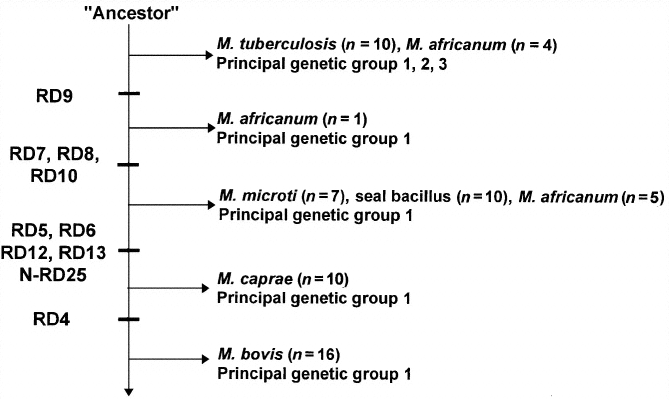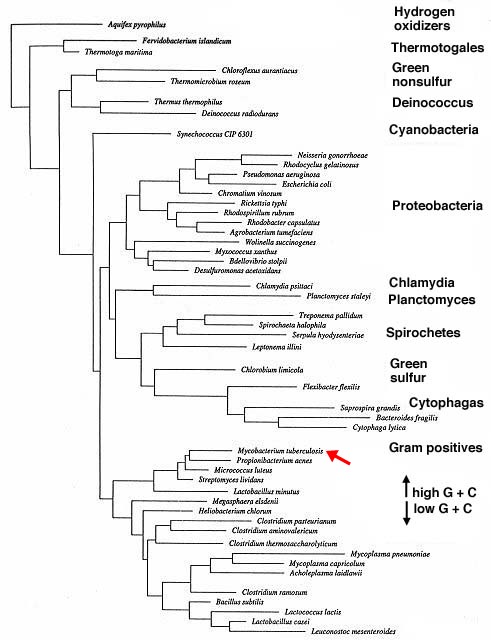|
Mycobacterium tuberculosis |
|
Classification |
|
|
| Figure 1. Proposed phylogeny of the Mycobacterium tuberculosis complex. The phylogeny depicts the order in which members of the complex could have evolved from a common ancestor. The clusters to the left of the vertical axis represent genomic deletions that separate the subspecies. |
|
In the grander scheme of organization, Mycobacterium tuberculosis is classified under the domain Bacteria with other microorganisms that possess cell walls and lack nuclei (are prokaryotic). The phylum Actinobacteria, which is comprised of a single class by the same name, consists of bacteria that vary widely in their morphological, physiological, and genomic characteristics. Actinobacteria morphologies range from coccoid to rod-shaped to filamentous. Furthermore, bacteria in this grouping are Gram-positive with a high G + C (guanine and cytosine) content in their DNA (Figure 2). Under the order Actinomycetales, Actinobacteria take the form of rigid bacilli or filamentous cells that have a tendency to branch; thus, M. tuberculosis belongs with the Actinomycetales because the bacterium is rigid and rod-shaped. The suborder Corynebacterineae denotes that, in addition to having a Gram-positive type cell wall, M. tuberculosis bacilli are non-motile and do not produce spores. Within the family Mycobacteriaceae, bacterial cells typically do not branch, so any mycelium formation tends to be undeveloped. As with M. tuberculosis, most Mycobacteriaceae are aerobic organisms that parasitize both humans and animals. The classification Mycobacterium, the sole genus of the Mycobacteriaceae family, also indicates that the organism in question is slow-growing and acid-fast. Finally, the species name Mycobacterium tuberculosis distinguishes the bacterium from other species within the same genus, such as Mycobacterium leprae, which is the causative agent of the disease leprosy. The following is the complete taxonomic classification for the species Mycobacterium tuberculosis as stated in Bergey’s Manual of Systematic Bacteriology 2nd edition, volume one. |
|
Phylum: Actinobacteria Class: Actinobacteria Subclass: Actinobacteridae Order: Actinomycetales Suborder: Corynebacterineae Family: Mycobacteriaceae Genus: Mycobacterium
Species:
Mycobacterium tuberculosis |
| Figure 2. Phylogenetic tree showing relationships among the bacteria. The red arrow indicates the position of Mycobacterium tuberculosis within the grouping. |

